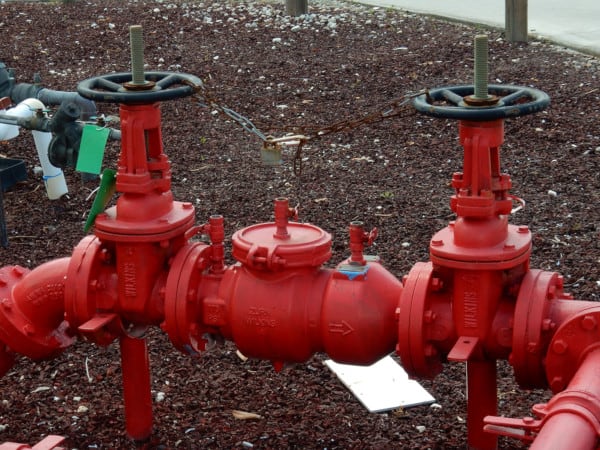Backflow preventers stop harmful contaminants from polluting a city’s drinking water
City water mains provide water for most homes and buildings, including the water used in fire protection systems. But the stagnant water that fills the pipes of wet fire protection systems is “non-potable”—it’s not fit to drink. Thus, water authorities often require property owners to install backflow preventers to keep stagnant water from mixing with the treated, “potable” water in the city water supply.
In this blog, we explain what property owners and facility managers need to know about backflow preventers, including:
- What are backflow preventers?
- How does a backflow preventer work?
- Are backflow preventers required in fire protection systems
Be sure to check out our selection of fire protection valves, gate valves, and fire sprinkler check valves that quickly and painlessly remove or install cam checks found in Ames and Watts backflow prevention assemblies.
What is “backflow?”
Water that enters a home or building’s fire protection, plumbing, or irrigation system from a main water supply line should only flow in one direction: into the property. But sometimes, pressure changes in the pipes can cause water to seep back into the main supply line.
For instance, a water-main break or the opening of a fire hydrant can cause water pipes to lose pressure. When that happens, water is no longer pushed forward into the property, enabling it to flow backward into city water supplies.
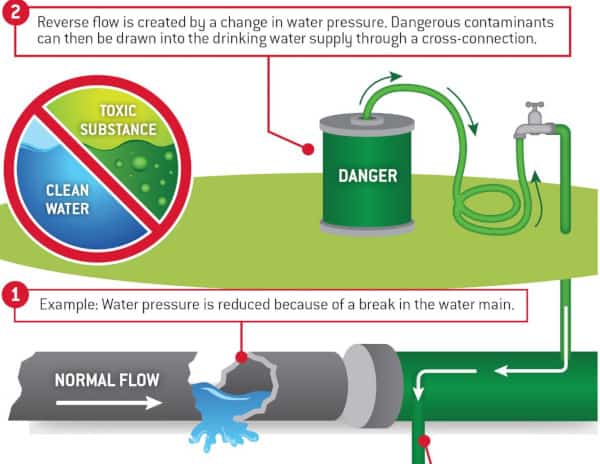
Backflow is dangerous because it can pollute the public drinking supply with contaminants like fertilizers, pesticides, human waste, and harmful chemicals. In 2010, for example, students at a Bowling Green, Kentucky elementary school suffered nausea and other symptoms after a contractor working on the HVAC system caused the antifreeze chemical glycol to backflow into the school’s drinking supply.
Such potential health dangers are alarming, but they aren’t the only problem. Backflow can also be extremely expensive to remediate. The Environmental Protection Agency (EPA) states that the average backflow incident takes nearly 500 hours to fix at a cost of $14,800.
Why is backflow from a fire sprinkler system especially alarming?
In wet fire protection systems like certain types of sprinklers or standpipes, a large volume of water never moves until it flows from an activated sprinkler head or a broken sprinkler pipe. When water is stagnant, bacteria can fester—transforming the sprinkler water into a thick, smelly, black, oily sludge that could potentially cause serious issues if it reverses into a city’s drinking supply.
Sprinkler systems connected to non-potable public water supplies or alternative sources of water can still pose contamination risks if the potential for a cross-connection exists to a city’s drinking water. Backflow from systems that contain antifreeze or other chemicals such as foam is also a serious concern.
What is a backflow preventer?
A backflow preventer is a device designed to keep water inside fire-protection and other water-based systems on a property—ensuring it only travels in one direction: from the water main into the system’s pipes.
Approved backflow assemblies have met the requirements of different approved testing agencies such as the American Society of Mechanical Engineers (ASME), the American Society of Sanitary Engineer (ASSE), the American Water Works Association (AWWA), the American National Standards Institute (ANSI), the Factory Mutual Research Corporation (FM), and UL (formerly Underwriters Laboratory).
Several types of backflow preventers exist, and each is intended for specific applications. The most common assemblies include:
Double Check Valves (DCV)
DCVs are specifically designed to prevent backflow in fire sprinkler systems. The mainstay for normal fire protection applications, DCVs feature an inlet (upstream) shutoff valve, two independently operating spring-loaded check valves (usually inside a single valve body), four test cocks, and an outlet (downstream) shutoff valve.
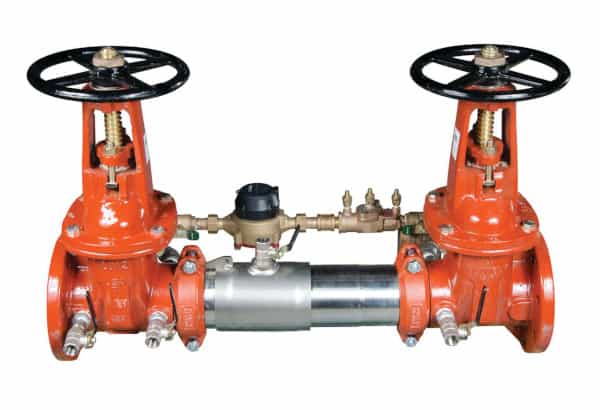
Reduced Pressure Zones (RPZ)
Touted as the most complex and reliable backflow preventers, RPZ assemblies are primarily intended for a building’s internal systems like plumbing or fire protection. In fire protection systems, they are most commonly used when hazardous chemicals like antifreeze or corrosion inhibitors are introduced—although some municipalities require RPZs on all fire protection applications.
RPZs expand upon the double check valve concept with a hydraulically operated relief valve that makes them virtually foolproof. They typically consist of an inlet shutoff valve, two spring-loaded check valves separated by a pressure differential relief valve, four test cocks, and an outlet shutoff valve.
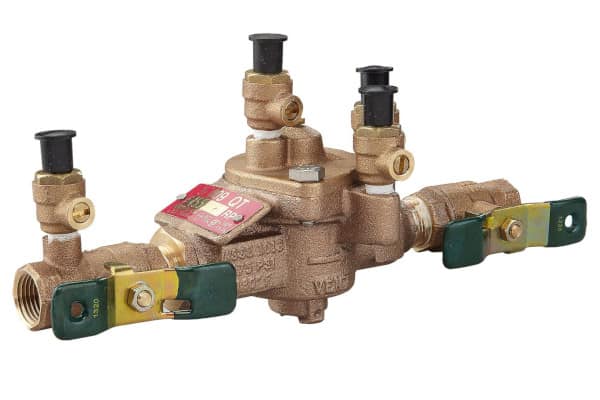
Pressure Vacuum Breakers (PVB)
PVB assembles, intended for lawn irrigation, are the least expensive type of whole-system backflow preventer. They are relatively simple in design and the easiest to install, maintain, and repair.
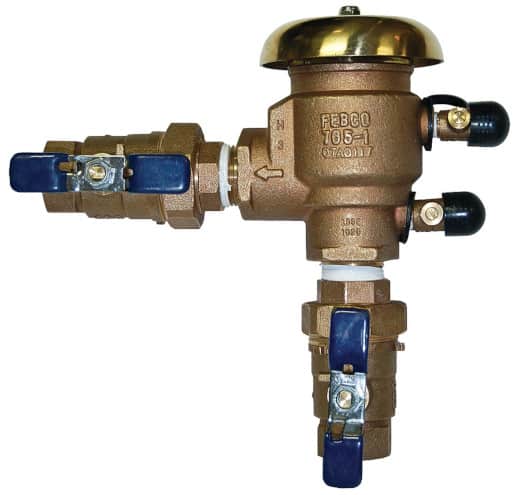
How does a backflow preventer work?
On a fire protection system, backflow preventers rely on two one-way valves, or check valves, assembled in a series to prevent water from backing up into the supply line. Think of the check valves as one-way gates, only allowing water to flow through them in one direction.
The double check assembly was developed in the 1950s for the fire protection industry, creating a redundancy designed to ensure that one check valve will continue to protect the city water supply even if the other fails. This assembly also enables the closure of one valve to reduce the pressure differential across the other, creating a more reliable seal and avoiding even minor backflow leakage. Test cocks, or small ball valves, enable the attachment of testing equipment that evaluates whether the double check assembly is functional.
Any time the pressure on the property (downstream) side exceeds the pressure on the city side, the two redundant check valves close—preventing any backflow. However, while DCV systems are considered safe for most fire protection systems, they do have a flaw: if both valves fail or debris in the water line prevents them from closing completely, backflow can occur.
Watch this video to understand how double check valve backflow preventers work:
RPZ assemblies also feature two independently operating check valves. However, they add another layer of protection that makes them essentially fail-safe by also locating a hydraulically operated differential relief valve below the first check valve.
Here’s how it works: During normal operation, the pressure between the two check valves—referred to as the zone of reduced pressure—is maintained at a lower pressure than the supply pressure. If either check valve should leak, the relief valve is designed to open and discharge water to the outside, ensuring backflow never occurs.
It’s important to understand that RPZ assemblies, while more reliable, experience much higher pressure and volume loss than double-check assemblies. Fluctuations in line pressure, upstream or downstream, will prompt a properly functioning RPZ assembly to periodically discharge small amounts of water. During a backflow condition, a large volume of water will flow from the relief valve. For this reason, RPZ assemblies shouldn’t be installed in areas subject to water damage. Adequate drainage must also be provided.
It’s also essential to note that both types of backflow preventers reduce available downstream water pressure. A knowledgeable contractor must account for this when designing fire protection systems.
Watch this video for a step-by-step illustration of how RPZ backflow preventers work:
Are backflow preventers required on fire protection systems?
There’s often confusion about whether National Fire Protection Association (NFPA) standards require backflow preventers on fire protection systems. Let’s be clear: they do not.
Requirements in NFPA 13: Standard for the Installation of Sprinkler Systems for installing backflow preventers and in NFPA 25: Standard for the Inspection, Testing and Maintenance of Water-Based Fire Protection Systems for performing annual forward flow tests are sometimes perceived as a mandate to have them. But the intent of the code is to only attach installation and ITM requirements to systems where backflow preventers are present.
In fact, reverse flow testing designed to ensure that backflow preventers prevent backflow was removed from NFPA 25 in 2011. While NFPA recognizes that backflow remains a legitimate health concern, it considers preventing it outside the scope of NFPA 25. Instead, NFPA presumes that local or state requirements will ensure that backflow preventers are properly tested by qualified personnel.
Backflow preventers are otherwise required in many fire protection systems, however. Mandates for installing backflow preventers are set forth by local plumbing codes developed and enforced by organizations like municipalities, water purveyors, and plumbing inspectors to protect local drinking supplies.
These organizations view backflow prevention through the broad lens of the overall community need—and recognize that every cross-connection between a wet building system and city water has the potential to trigger a serious backflow event. Water purveyors also typically require backflow preventers to be tested regularly and maintained by certified professionals to ensure they are reliable and functioning properly. It is important to check with your local water authority to understand specific requirements for backflow preventers in your area.
Backflow preventers are required in fire protection systems by the 2018 edition of the Uniform Plumbing Code, the model code developed by the International Association of Plumbing and Mechanical Officials (IAPMO) to promote the public’s health, safety, and welfare by governing the installation and inspection of plumbing systems.
The American Water Works Association (AWWA) supports model code requirements by offering guidance for when backflow preventers should be installed based on the degree of hazard presented by a fire protection system. A low-hazard cross-connection might create a nuisance or would be aesthetically objectionable if there is a backflow incident but would not create a health hazard. An unprotected high-hazard cross-connection is a health hazard, involving any substance that could cause death or illness or spread disease if it is introduced into the city’s water supply.
In commercial applications, for instance, AWWA M-14: Backflow Prevention and Cross-Connection Control Recommended Practices recommends a DCV assembly on wet or dry sprinkler systems unless there is a risk of a high-hazard cross-connection. In those cases, an RPZ assembly is suggested.
From the 2018 edition of Uniform Plumbing Code (UPC)
603.5.14 Except as provided under Section 603.5.14.1 and Section 603.5.14.2, potable water supplies to fire protection systems that are normally under pressure, including but not limited to standpipes and automatic sprinkler systems, except in one – or two-family or townhouse residential sprinkler systems, piped in materials approved for potable water distribution systems shall be protected from backpressure and backsiphonage by one of the following testable devices:
(1) Double check valve backflow prevention assembly (DC)
(2) Double check detector fire protection backflow prevention assembly
(3) Reduced pressure principle backflow prevention assembly (RP)
(4) Reduced pressure detector fire protection backflow prevention assembly
Potable water supplies to fire protection systems that are not normally under pressure shall be protected from backflow and shall be in accordance with the requirements of the appropriate standards referenced in Table 1701.1.
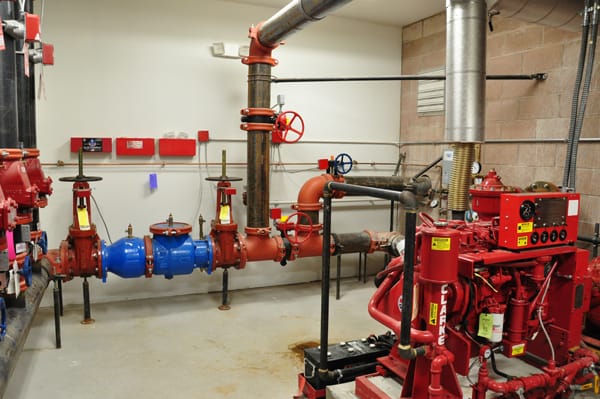
While UPC does differentiate between residential and commercial systems, its leniency only applies to residential systems using potable water piping materials. In one- and two-family dwellings, AWWA states that backflow preventers are not needed on sprinkler systems constructed of approved potable material and designed to flow water, so it doesn’t stagnate. Instead, backflow requirements for domestic plumbing could apply to those sprinkler systems.
Some jurisdictions also allow alternatives to backflow preventers. For instance, Philadelphia’s water district requires all residential systems supplying dedicated sprinkler heads to have a connection from the sprinkler system to the toilet tank that’s farthest from the water supply. This removes the need for a backflow preventer, because every time that toilet is flushed, it draws water through the fire line to keep the water fresh.
However, UPC model code requires stand-alone residential systems using non-potable fire protection piping materials to achieve the same level of protection as a commercial system. Increased protection is also required when chemicals are added to a fire protection system supplied by a potable water supply.
From the 2018 edition of the UPC
603.5.14.2 Where antifreeze, corrosion inhibitors, or other chemicals are added to a fire protection system supplied from a potable water supply, the potable water system shall be protected by one of the following:
(1) Reduced pressure principle backflow prevention assembly (RP)
(2) Reduced pressure detector fire protection backflow prevention assembly
The model plumbing code also requires backflow preventers on fire department connections (FDC) located less than 1,700 feet (518.2 m) from a non-potable water source that might be used by the fire department.
While fighting a fire, firefighters are understandably more concerned about drawing enough water to douse the blaze than backflow prevention. Not only will they use water from any available source to achieve their goal, but fire department vehicles often carry non-potable water treated with antifreeze, corrosion inhibitors, or extinguishing agents.
For those reasons, the model code often treats fire protection systems with FDC connections as high-hazard situations for backflow.
From the 2018 edition of the UPC
603.5.14.1 Where fire protection systems supplied from a potable water system include a fire department (Siamese) connection that is located less than 1700 feet (518.2 m) from a non-potable water source that is capable of being used by the fire department as a secondary water supply, the potable water supply shall be protected by one of the following:
(1) Reduced pressure principle backflow prevention assembly (RP)
(2) Reduced pressure detector fire protection backflow prevention assembly
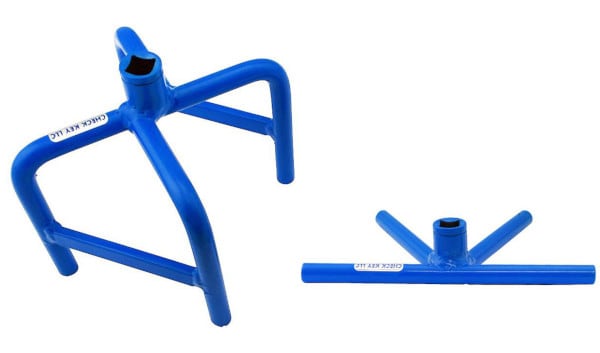
Backflow preventers are key to maintaining the purity and safety of a city’s water supply
Backflow from fire protection systems can threaten the safety of potable water. Understanding how backflow preventers work and why they are important in a home or business helps property owners prevent avoidable accidents—and meet code requirements in their area.
Make sure to check with your local authority having jurisdiction (AHJ) on the exact backflow prevention requirements for your area, system, and occupancy type.
If you need to maintain a backflow preventer in your fire protection system, be sure to check out our selection of fire protection products. They painlessly remove or install cam checks found in Ames and Watts double check and reduced pressure zone backflow prevention assemblies.
This blog was originally posted at blog.qrfs.com. Check us out at Facebook.com/QuickResponseFireSupply or on Twitter @QuickResponseFS.


